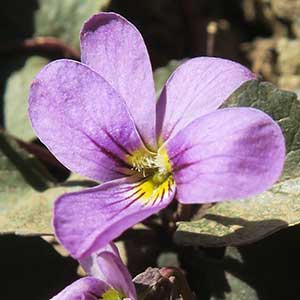Viola flettii
Violaceae
Flett's violet, Olympic violet, rock violet
violet family
1–3, ascending to erect, mostly glabrous, on caudex from fleshy rhizome.
0–20, prostrate to erect.
basal and cauline;
basal: 1–3;
stipules linear-lanceolate, margins entire or with glandular processes, apex acuminate;
petiole 1.5–9.7 cm, mostly glabrous;
blade purple-tinted and –veined, broadly reniform to ovate, 0.9–2.4 × 1.2–4 cm, base cordate, margins finely crenate-serrate, eciliate, apex acute to obtuse, surfaces glabrous or sparsely pubescent along veins adaxially;
cauline similar to basal except: stipules ovate to lanceolate, margins entire or shallowly laciniate;
petiole 0.7–5.9 cm, usually glabrous;
blade 0.8–2.1 × 1.2–3.1 cm.
cauline or basal, (attached directly to rhizome, some Viola), alternate (and opposite in Hybanthus [and other genera]), simple or compound, stipulate [estipulate], petiolate or sessile;
blade unlobed or lobed.
1(–4)[–5]-flowered, axillary from leaf axils or scapose from rhizomes or stolons (or in racemes of umbels), pedunculate;
bracteoles usually present on peduncles, usually alternate.
1.8–7.1 cm, usually glabrous.
sepals lanceolate, margins eciliate, auricles 0.5–1.5 mm;
petals soft reddish violet on both surfaces, all with yellow area basally, lower 3 dark violet-veined, lateral 2 bearded, lowest with white around yellow area, 10–15 mm, spur yellow, gibbous, 0.5–2 mm;
style head bearded; cleistogamous flowers axillary.
bisexual [unisexual, plants dioecious], perianth and unequal, imbricate in bud [convolute], lowermost petal often larger with gibbous or elongated spur;
stamens 5, alternate with petals, surrounding ovary, connivent or syngenesious;
filaments 0–1 mm, filaments of 2 anterior stamens often with nectaries protruding into spur, anther dehiscence by longitudinal slits;
pistil 1, [2–]3[–5]-carpellate;
ovary superior, 1-locular;
placentation parietal;
ovules [1–2]8–75, anatropous, bitegmic, crassinucellate;
style [0–]1, usually enlarged distally, solid or hollow;
stigma 1 [3–5], with or without hairs.
capsular [berry, nut], 3-valved, dehiscence loculicidal.
± spherical, 5–9 mm, glabrous.
dark brown to brownish purple, 2.5–3 mm.
[1–](3–)6–75, hard, embryo not developed at time of dispersal, spheroid or ovoid [strongly flattened], glabrous [hairy], some arillate, some with elaiosome [seeds winged in some woody vines].
Viola flettii
Violaceae
Viola flettii is endemic to the Olympic Mountains of northwestern Washington. C. S. McCreary (2005) noted that although morphologically and ecologically distinct, V. cuneata, V. flettii, and V. ocellata are closely related.
(Discussion copyrighted by Flora of North America; reprinted with permission.)
Genera 23, species 1000–1100 (2 genera, 78 species in the flora).
The Violaceae is predominantly tropical with worldwide distribution. Most genera are monotypic or oligotypic and are restricted to the New World or Old World tropics (H. E. Ballard et al. 1998; G. A. Wahlert et al. 2014). Except for Viola, Hybanthus, and Rinorea, which together account for 98% of all species in the family, most genera are limited to one continent or island system (M. Feng 2005).
Violaceae has been placed in the Violales by most authors (A. Cronquist 1981; R. F. Thorne 1992; A. L. Takhtajan 1997). Based on data from cladistic analyses, it was included in the Malpighiales in 1998 (Angiosperm Phylogeny Group 1998, 2003, 2009).
The Malpighiales clade was first identified by M. W. Chase et al. (1993) in a phylogenetic analysis of nucleotide sequences from the plastid gene rbcL (K. J. Wurdack and C. C. Davis 2009). Currently, 35 families are included in Malpighiales (Angiosperm Phylogeny Group 2009). Molecular studies employing multiple gene regions have confirmed the monophyly of Malpighiales, which includes about 16,000 species (Wurdack and Davis). Relationships within Malpighiales remain poorly understood and it is the most poorly resolved large rosid clade (Wurdack and Davis).
Violaceae were previously organized into three subfamilies, Fusispermoideae, Leonioideae, and Violoideae (W. H. A. Hekking 1988; S. A. Hodges et al. 1995). Evidence confirms that Fusispermum is basal in Violaceae and belongs in the monotypic subfamily Fusispermoideae (M. Feng 2005; T. Tokuoka 2008) and Leonioideae should be subsumed in Violoideae (Feng; Feng and H. E. Ballard 2005; Tokuoka). All genera in Violaceae except Fusispermum are currently included in the subfamily Violoideae. Usually described as having an actinomorphic corolla, the calyx and corolla of Fusispermum were reported to actually be weakly zygomorphic (G. A. Wahlert et al. 2014).
W. H. A. Hekking (1988) divided subfamily Violoideae into two tribes, Violeae and Rinoreeae. Viola and Hybanthus, the only two genera in the flora area, are placed in the Violeae.
In a study of Violaceae based on plastid and nuclear DNA sequences (rbcL, atpB, matK, and 18s rDNA), T. Tokuoka (2008) found that monophyly of the family is strongly supported. A study of 39 species of Viola occurring primarily in China using chloroplast sequences trnL-trnF, psbA-trnH, rpL16, and ITS showed that “subgenus” Viola is not monophyletic (Liang G. X. and Xing F. W. 2010). Their data imply that 1) erect stems may be more primitive than stolons or rosettes, 2) species with stigmatic beaks might have been trends in sections Trigonocarpae and Adnatae, respectively.
A study of Violaceae based on plastid DNA sequences showed that most intrafamilial taxa from previous classifications of Violaceae were not supported, that previously unsuspected generic affinities were revealed, and that reliance on floral symmetry (that is, actinomorphy versus zygomorphy) alone provides misleading inferences of relationships and heterogeneous generic circumscriptions (G. A. Wahlert et al. 2014).
(Discussion copyrighted by Flora of North America; reprinted with permission.)
1. Plants caulescent; sepals not auriculate; upper 2 and lateral 2 petals not showy, 0.5–5 mm; lowest petal showy, narrowed at middle; stamens connate, lowest 2 filaments not spurred with nectary; seeds (3–)6–9. | Hybanthus |
1. Plants caulescent or acaulescent; sepals auriculate; upper 2 and lateral 2 petals showy, 5+ mm; lowest petal showy, not narrowed at middle; stamens connivent, but distinct, lower 2 filaments spurred with nectary that protrudes into petal spur; seeds 6–75. | Viola |
- Local floras:
CA,
OR
- Local Web sites:
CalFlora,
CalPhotos,
Flora NW,
PNW Herbaria
WildflowerSearch
iNaturalist (observations)
- LBJ Wildflower Center
- SEINet
- Plants of the World Online
- Encyclopedia of Life
- Wikipedia
- Google Image Search


